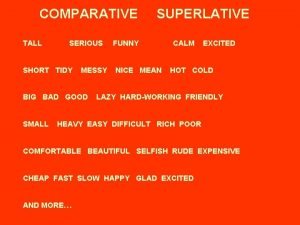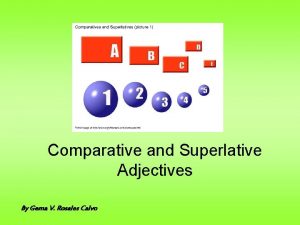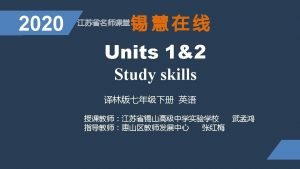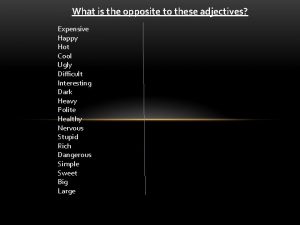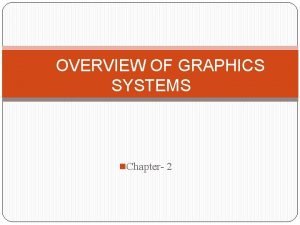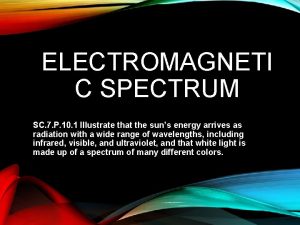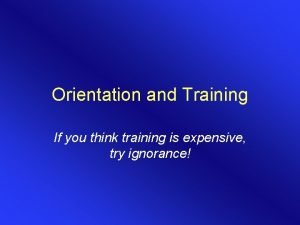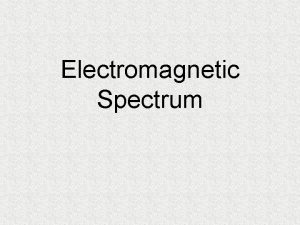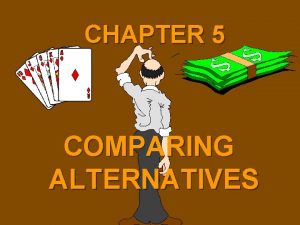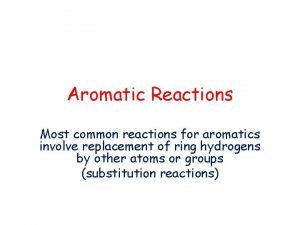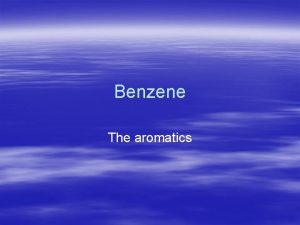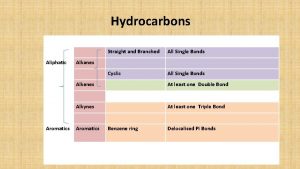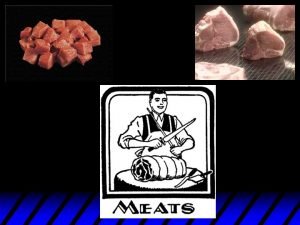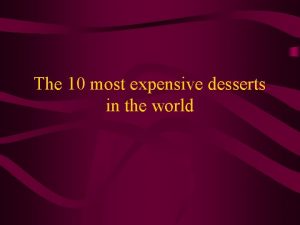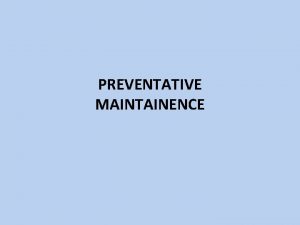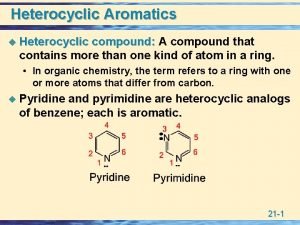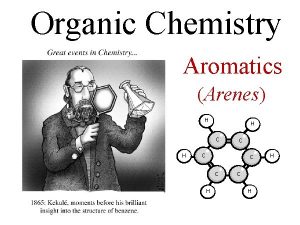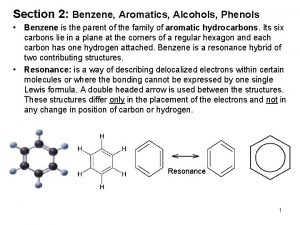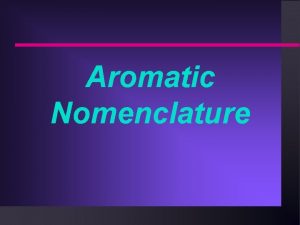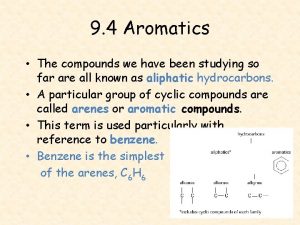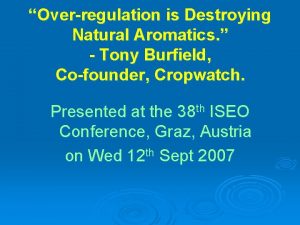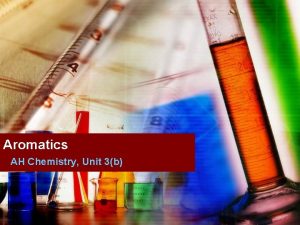Alternatives to OilDerived Aromatics The Most Expensive and























- Slides: 23

Alternatives to Oil-Derived Aromatics: The Most Expensive and Toxic Gasoline Component Governors’ Biofuels Coalition May 18, 2012 This presentation was adapted from a Governors’ Biofuels Coalition presentation to White House Domestic Policy Council Staff on March 1, 2012

CONGRESS GAVE EPA SWEEPING AUTHORITY TO REGULATE GASOLINE AROMATICS IN 1990 CAAA � Average gallon of U. S. gasoline contains 25% 2 aromatics, aka BTX Group (benzene, toluene, xylene) to increase octane rating (approx. 35 billion GPY toluene equivalent) � In 1990 CAAA, Congress explicitly cited the health dangers posed by aromatics, and directed EPA to seek “the greatest degree of emission reduction achievable through the application of technology which will be available, taking into consideration…the availability and costs of the technology. . and lead time. ” � Section 211(c)(1)(A) of the Act also empowers EPA to control the manufacture of any fuel if it can “reasonably anticipate” that an emission product of

A GRADUAL PHASE-DOWN IN AROMATICS LEVEL COULD REDUCE GASOLINE COSTS, CARBON AND FINE PARTICULATE/TOXICS EMISSIONS, AND PETROLEUM USE � Aromatics are the most costly gasoline component (costs tied to crude oil, from which it is derived) � Aromatics are the most energy inefficient (energy intensive reforming process is responsible for significant product yield losses at the refinery) � Aromatics are the most carbon intensive gasoline component � Aromatics combust with greater difficulty due to the strong bonds of the basic six-atom carbon ring, which makes it such a disproportionately large share of IC engine emissions � Aromatics are the primary anthropogenic precursor of: 1) urban air toxics; 2) urban PM secondary organic aerosols (SOAs); and 3) the most pathogenic sub-group of PM, ultrafine particulates (UFPs) 3

EPA HAS CALLED PM THE NATION’S GREATEST HEALTH THREAT � 85% of $2 trillion in savings projected for 2020 will come from reductions in ambient particulate matter (PM 10 & PM 2. 5) http: //www. epa. gov/air/sect 812/prospective 2. html � By 2020, some experts believe that a majority of PM 2. 5 will come from mobile sources [See “The Benefits and Costs of the Clean Air Act from 1990 to 2020”, Final Report, U. S. Environmental Protection Agency, Office of Air and Radiation, March 2011, p. 5 -13, Table 5 -3] � EPA projects that OC (organic carbon) from mobile sources will be 4 responsible for nearly twice the PM 2. 5 (3. 99 micrograms per cubic meter) as SO 4 (2. 22), and four times more PM 2. 5 than crustal (0. 96), the next largest source � EPA has said it will adjust its models to correct for their substantial under-prediction of secondary organic aerosols (SOAs) from mobile sources http: //www. cmu. edu/news/archive/2007/March/march 1_soot. shtml � If the most lethal sub-group of PM (ultrafine particulates) were regulated, health cost savings would be orders of magnitude greater than estimated by EPA’s March 2011 report, substantially benefiting to the nation’s economy, environment, and quality of life

THREE SIZE CATEGORIES FOR PM � Coarse-mode = 2. 5 micrometers or larger, primarily mechanically generated particles � Accumulation-mode (PM 2. 5) = between 0. 1 and 2. 5 micrometers in diameter, from aggregation of UFPs and vapors � Ultrafine particles (UFPs) = smaller than 0. 1 micrometer, largely organic primary combustion products http: //ehp 03. niehs. nih. gov/article/fetch. Article. action? article. URI=info: doi/10. 1289/ehp. 7939, p. 2 5

EPA REGULATES PARTICLES ONLY ON THE BASIS OF MASS, NOT NUMBER � Most motor vehicle particles are in the very toxic ultra-fine range, but their particle numbers are not regulated by ambient air quality standards � Contrary to conventional wisdom, newer vehicles tend to emit LESS particle MASS, but MORE particle NUMBERS (UFPs), by as much as four-fold http: //eosweb. larc. nasa. gov/PRODOCS/narsto/document/EPA_SS_Los_Angeles_Final_Re port. pdf, p. 3 � UFPs are much more pathogenic than other PM, due to their smaller size and larger particle numbers; larger content of redox active compounds; greater bioavailability; and greater lung retention http: //www. particleandfibretoxicology. com/content/6/1/24/ref, pp. 6 - 7 � Recent mainstream media (Wall Street Journal, New York Times, etc. ) articles have underlined the growing health threat posed by fine particles, including secondary organic aerosols, and the toxics that coat them (PAHQs) http: //online. wsj. com/article/SB 10001424052970203733504577024000381790904. html http: //www. nytimes. com/2012/02/19/science/earth/scientists-find-new-dangers-in-tiny-but-pervasive-particles-in-airpollution. html? _r=1&emc=eta 1 6

Health Effects Testing 11/8/11 Wall Street Journal article– “The Hidden Toll of Traffic Jams” Columbia University's Frederica Perera discusses the link between exposure to pollutants in the womb and mental impacts in children 2/18/12 New York Times article – “Scientists Find New Dangers in Tiny but Pervasive Particles in Air Pollution 12/16/10 Los Angeles Times article– “Proximity to freeways increases autism risk, study finds”

AROMATICS ARE THE PRIMARY SOURCE OF URBAN MSATs, PM 2. 5 SOAs, & UFPs � “Apportionment of total VOCs to sources showed that gasoline exhaust was the � � � 8 predominant source for both on-road and near-road concentrations ranging from 70% for some of the samples at the near-road sites to about 100% for on-road samples. The contribution of diesel exhaust was small (22%)…Apportionment of BTEX showed that gasoline was the dominant source (94% to 100%) for all on-road samples…as well as those from the near-road sites (83% to 100%). ” [Source: HEI Synopsis of Research Report 156, “Concentrations of Air Toxics in Motor Vehicle-Dominated Environments”, Fujita, et. al. , 2011] “Toluene and other aromatics have long been viewed as the dominant anthropogenic secondary organic aerosol precursors. . . “. http: //www. atmos-chemphys. net/9/2973/2009/acp-9 -2973 -2009. pdf EPA recognizes that its models under-predict the aromatics contribution to SOAs. In its March 2011 report on the benefits and costs of the Clean Air Act, EPA noted that its CMAQ model has “known biases (under-prediction) in SOA formation”, and described the error as being “possibly major. The modeling system under-predicts SOA…there may be large benefits from SOA-related reductions that are not currently captured by the modeling system. ” [Attachment A, Table 4 – 1, and pages 4 -24 -25]. In the 2007 regulatory impact analysis of the RFS, EPA said it would correct the SOA modeling by the end of that year, but it has not yet done so. http: //www. epa. gov/sciencematters/june 2010/scinews_airqualitymodeling. htm In a 2010 SAE paper, Honda scientists reported that their predictive modeling “indicated that aromatics with a high boiling point and a high double bond equivalent (DBE) value tended to produce more PN emissions…all of the additional PN is considered a PAH…with a high boiling point or soot. The higher the boiling point hydrocarbon added, the more the PN increases. This trend is particularly notable with aromatic substances. ” [ Source: SAE International, “Development of a Predictive Model for Gasoline Particulate Matter Emissions”, Aikawa, et. al. , 2010 -01 -2115. ]

EPA SUGGESTS THAT ITS NEW MODELS WILL CORRECT UNDER-REPORTING OF SOA FROM MOBILE SOURCES � November 2006 EPA solicitation for research stated that “It is well established that aromatic hydrocarbons, primarily from vehicle emissions, can form SOA…However, existing chemical mechanisms do not incorporate the newly discovered particle-phase reactions, acid-catalyzed reactions, and heterogeneous reactions that lead to large amounts of SOA formation…Increasing evidence points toward the formation of oligomers, especially by SOA from aromatic precursors. ” [“Sources and Atmospheric Formation of Organic Particulate Matter”, FON: EPA-G 2007 -STAR-E 1, Tom Barnwell, EPA, Washington, DC] � In a 2010 study, EPA experts confirmed that mobile source primary carbonaceous particulate matter (aromatics) were major catalysts in transforming biogenic VOCs into SOA, and that reducing mobile source emissions could reduce SOA emissions in the eastern U. S. by as much as 50% or more. [See, e. g. , Carlton, Bhave, Edney, Sawar, Pinder, Pouliot, & Houyoux, Model Representation of Secondary Organic Aerosol in CMAQv 4. 7, 44 Envtl. Sci. Tech. 8553 (2010). ] 9 � “EPA intends to use the most recent version of CMAQ, which reflects updates to version 4. 7 to improve the underlying science. ” [GHG – CAFE Proposed

10

E 30 BLENDS SIGNIFICANTLY REDUCE PN EMISSIONS IN BOTH PFI AND GDI ENGINES � 2010 CARB/Zhang study found that higher level ethanol blends (E 35, E 65, E 85) reduced UFPs in Port Fuel Injection (PFI) engines by 70 – 90% http: //www. calevc. org/carbzhang. pdf , slides 19 and 23 � December 2011 Ford Research paper found higher level ethanol blends (E 32, E 47) reduced PM and PN emissions for Gasoline Direct Injection (GDI) engines by 30 – 45% [“The Impact of Ethanol Fuel Blends on PM Emissions From a Light-Duty GDI Vehicle”, Maricq et al. , Aerosol Science and Technology, 46: 576 -583, 2012] 11

12

UFPs ARE ALSO PRIMARY SOURCE OF AIR TOXICS IN URBAN AREAS � “Evidence now supports the view that UFPs carry considerable amounts of air toxics…a large proportion of UFPs are made up of organic carbon, followed by EC as primary products from mobile source emissions…Other studies showed that UFPs contain the largest fraction of polycyclic aromatic hydrocarbons (PAHs) by mass. ” http: //ehp 03. niehs. nih. gov/article/fetch. Article. action? article. URI=info: doi/10. 1289/ ehp. 7939, p. 4 � “Given these findings, if PAHs and other organic compounds are major causal components of the inflammatory response to PM, then greater responses from UFPs compared with larger particles are expected in urban areas in the proximity of mobile sources. This expectation is further supported by the greater PN and surface area of the UFPs, and greater internal doses due to the higher respiratory deposition of UFPs. ” [supra, p. 4] � Carnegie – Mellon’s 2007 study for EPA found that the secondary 13 chemical processes caused the pollution to spread over a much larger geographic area. “We’re seeing that urban pollution doesn’t stay contained in the cities, but impacts rural and other downwind areas…”. http: //www. cmu. edu/news/archive/2007/March/march 1_soot. shtml

MANY PAHs IN CIGARETTE SMOKE ARE THE SAME PAHs PRODUCED BY COMBUSTION OF GASOLINE BTX � Some of the PAHs found in cigarette smoke are the same as the PAHs that coat UFPs, which lodge deeply into humans’ lungs, and are carried to the organs by the bloodstream. http: //envirocancer. cornell. edu/Factsheet/general/fs 41. pah. cfm � UCLA/USC researchers called PAH, etc. coating of UFPs a “Cellular energy crisis: particulate hitchhikers damage mitochondria”. They said that “one of the body’s most important processes—energy production in the cell—can be significantly disrupted by exposure to UFPs…the team isolated organic ‘hitchhiker’ substances such as PAHs and quinones that had attached to the particle cores”. http: //www. thefreelibrary. com/Cellular+energy+crisis%3 a+particulate+hit chhikers+damage+mitochondria-a 0134257218 � PAHs and quinones are both derivatives of aromatics/BTX and combustion by-products of gasoline. “…carbonaceous aerosols derived from domestic burning of…gasoline have much higher concentrations of PAHs than those derived from domestic burning of biomass. ” http: //www. highbeam. com/doc/1 G 1 -242900458. html? key=0142160 D 517 E 1 A 106 B 1 A 0 A 021 B 03664 B 2 E 224 E 324 D 3417295 C 30420 B 61651 B 617 F 137019731 B 7 B 1 D 6 B 39 14

Mounting Evidence – PAH Impact Studies “Prenatal exposure to pollutants in city air is linked to later anxiety, depression and behavior problems in children. ” – Columbia University Study as reported in TIME Magazine 15 Children born to mothers with the highest PAH levels during their third trimester had a 79% greater risk of becoming obese, compared with children born to moms with the lowest PAH levels. – reported in the American Journal of Epidemiology April 2012 Dr. Frederica Perera at Columbia University, showed women with higher levels of PAH residues in their blood [resulting from air pollution] at the time of delivery were 23% more likely to have children scoring higher on anxiety and depression measures than those with lower

CARBONACEOUS PARTICLE REDUCTION OFFERS HIGHEST $/TON IN BENEFITS � “…carbonaceous particles tend to be emitted in close proximity to population centers. In fact, area source and mobile source particle emissions, in particular, show the highest $/ton, suggesting that the emissions and population centers exposed are co-located. ” [“The influence of location, source, and emission type in estimates of the human health benefits of reducing a ton of air pollution”, Fann, et al. , EPA Office of Air Quality Planning & Standards, Air Qual Atmos Health (2009) 2: 169 – 176. ] � White House OMB values mobile source precursors of PM 2. 5 at twice the level of stationary source emissions. [See OMB 2003 Report to Congress on Cost and Benefits of Federal Regulations, Sept. 2003. OMB noted that “mobile source tailpipe emissions are located in urban areas at ground level (with limited dispersal) while electric utilities emit NOx from tall stacks located in rural areas with substantial geographic dispersal”. ] � However, EPA does not allow States to take credit for mobile source particulate reductions in their SIP plans 16

EPA CERTIFICATION FUELS & TESTING PROCEDURES DO NOT ACCURATELY PREDICT REAL-WORLD POLLUTION EFFECTS � “…gasoline-powered vehicles were also observed to produce comparably 17 higher UFP counts, particularly when the vehicles were older; when vehicles were accelerating hard or from a standing start, such as after waiting at a stop light; and when vehicles were driven/accelerated at high speeds. Because of the ubiquitous nature of gasoline-powered vehicles, and the frequency of this type of driving, they may be the predominate source of in-vehicle, roadway, and near-roadway concentrations. ” [http: //ehp 03. niehs. nih. gov/article/fetch. Article. action? article. URI=info: doi/10. 1 289/ehp. 7939 supra, p. 10] � The use of indolene as a cert fuel, and the restricted parameters of EPA emissions tests (e. g. , only moderate acceleration with limited high load conditions, etc. ) mask the actual emissions results in start – stop; higher speeds; and acceleration driving on freeways and other congested roadways near high population areas. � A 2007 CARB-sponsored study warned: “These data show that the FTP cycle resulted in the lowest overall ultrafine and fine PM emissions of all the cycles tested, a result consistent with previous studies. Agencies considering the use of the FTP cycle during routine monitoring and inspection programs should thus recognize the possibility of underestimating PM emissions inventories for transportation sources. ” (emphasis supplied)

ADVANCED ENGINE DESIGNS COULD INCREASE PARTICLE NUMBER & WORSEN UFP EMISSIONS IN THE ABSENCE OF FUEL COMPOSITION CHANGES � OEMs will rely heavily on advanced technologies such as direct injection, turbo- charging, & lean-burn combustion to comply with tighter fuel efficiency standards � However, many experts warn that while these and other changes to vehicle hardware may help to reduce particle MASS, they are likely to worsen particle NUMBER emissions. For instance, in its 2010 discussion paper on its LEV III regulations, CARB stated that “ARB staff acknowledges that the PM particle count emitted from motor vehicles poses a separate health effect from those of PM mass emissions and that reductions in PM mass have the potential to increase the number of particles emitted. ” CARB went on to say that “Some of the most promising efficiency technologies present challenges to simultaneously constrain PM levels to today’s levels while also reducing CO 2 emission levels. ” http: //www. arb. ca. gov/msprog/leviii/meetings/030210/lev_iii_discussion_paper_2 -10. pdf � In its 2010 SAE paper, Honda said that “PM emissions will not decrease as long as the percentage of fuels that generate more PM emissions increases in the market. As a result, efforts are needed to not only improve engine hardware, but also to improve gasoline quality worldwide. ” [supra, p. 8] � In a March 2009 paper, the University of Oxford and Ford Motor Co. noted that “PM & 18 PN [are] strongly dependent on fuel composition – more so than for most of the above [vehicle calibration factors]”, and that “Oxygenates (e. g. , ethanol, butanol) [are] good at suppressing PM…”. They concluded by saying that “Fuel composition has a role to play – aromatics increase soot production whilst oxygenates help suppress soot. ” http: //www-diva. eng. cam. ac. uk/energy/nickparticle/particle_meeting_09/PPrice , Slides 17

NEW ENGINE TECHNOLOGIES & INCREASED UFP EMISSIONS (Cont’d) � 2005 USC/UCLA Southern California Supersite study on PM found that “Compared to previous studies…less particle MASS but more particle NUMBERS (by a factor of 2 – 4 fold) are emitted by vehicles than was the case 7 years ago. As the emissions of carbonaceous PM of new engines decreases, the formation of nucleation mode particles [UFPs] is favored due to the reduction of the available surface for the adsorption of the semi-volatile material. The resulting supersaturation of the mostly organic vapor increases the production of nanoparticles by nucleation. ” http: //eosweb. larc. nasa. gov/PRODOCS/narsto/document/EPA_SS_Los_Angeles_Final_Rep ort. pdf, p. 3, 13 � “The majority of these particles are not emitted directly, but are the result of 19 condensation of vapors…This implies that conventional PM control technologies, such as filters, may not by themselves reduce effectively particle number emissions from mobile sources, and effective reduction may only be accomplished by controlling the emissions of the condensing vapors in the vehicles exhaust. ” (emphasis supplied) [Source: Supra, p. 20] � “DISI engines can be more efficient…and also offer a performance benefit…However, DISI engines tend to make more PM than their port-injected counterparts, with PM mass levels exceeding those of diesels equipped with diesel particulate filters”. [Source: “Ethanol Blend Effects on Direct Injection Spark-Ignition Vehicle Particulate Matter Emissions”, Storey, et. al. , Oak Ridge National Labs, 2010 -01 -2129, 10/25/2010. ]

OPPORTUNITY EXISTS TO SYNCHRONIZE FUEL EFFICIENCY, FUEL COMPOSITION, & PETROLEUM/CARBON INTENSITY REDUCTION GOALS BETWEEN NOW AND 2025 � EPA’s final GHG – CAFE rule must fairly incent OEMs to manufacture FFVs needed to accommodate the emergence of a nationwide Clean Octane program. EPA must also ensure that its rules do not result in air quality backsliding by balancing fuel quality standards with advanced engine design needs. � Section 211(c)(1)(A) empowers EPA to control the manufacture of any fuel if it can “reasonably anticipate” that an emission product of such fuel might endanger the public health or welfare � May 21, 2010 Presidential Memorandum on Fuel Efficiency directs EPA, DOT/NHTSA, DOE, etc. to establish uniform national vehicle and fuel standards to meet aggressive mileage standards and protect against backsliding and environmental damage due to fuel composition � EPA’s Tier 3 rulemaking might also offer actionable vehiclesfor aromatics control to achieve UFP and carbon intensity reductions. Alternatively, EPA could update its MSAT rulemaking based on new science and changing economics (last rule in 2007 assumed $20 crude oil). � Gradual reductions in gasoline BTX content will also make major contributions to President Obama’s goal of 33% reduction in petroleum imports by 2025 � Synchronizing the 2025 Phase II fuel efficiency standards with gradual improvements in 20 fuel composition during that same period offers one of the most cost effective, consumerfriendly, and technologically available pathways to achieving three critically important

AROMATICS SUBSTITUTES CAN BE SECURED ON A COST EFFECTIVE AND TIMELY BASIS � Alternatives include CNG, electric vehicles, and ethanol/biofuels � Aromatics are the most costly component in gasoline (as oil prices increases, so do BTX production costs), and the most energy inefficient, responsible for significant loss of gasoline and other product yield at the refinery http: //www. nrel. gov/analysis/pdfs/44517. pdf, see esp. pp. 15 - 20 � Recent changes to ethanol’s tax and import duty rules, and technology announcements such as the Celanese natural gas-toethanol advance, mean that ethanol sources and feed-stocks are expected to be be varied and market-based http: //www. marketwatch. com/story/third-party-engineering-experts-validate-ce � Since oil prices have surged, average toluene prices (USGC) have exceeded ethanol price by $1 or more per gallon (in recent months, USGC spot toluene prices have exceeded ethanol spot prices by nearly $2 per gallon) � EPA rulemaking could include BAT (banking, averaging, & trading) 21 mechanisms to facilitate cost-effective compliance


SUMMARY � EPA has statutory authority to require gradual reductions in 23 gasoline aromatics levels in order to protect the public health and welfare, and achieve substantial reductions in urban emissions of MSATs, PM 2. 5, and UFPs � Replacing aromatics with intermediate ethanol blends (e. g. , E 30) would also reduce gasoline yield loss at the refinery, significantly reduce retail gasoline prices, and help to insulate from price spikes in the future � Fuel composition changes should be synchronized with the new fuel efficiency standards to prevent inadvertent increases in urban UFP + PAHQ emissions and air quality backsliding � Allowing States to take credit for mobile source particulate emissions reduction would be a cost-effective means of protecting the public health and preventing air quality backsliding � More dialogue and coordination between the health community, auto manufacturers, and suppliers of BTX alternatives is warranted
 Training is expensive without training it is more expensive
Training is expensive without training it is more expensive Tidy in superlative form
Tidy in superlative form Superlative adjectives young
Superlative adjectives young Umbrella stressed syllable
Umbrella stressed syllable The watch was expensive he bought it
The watch was expensive he bought it Ingilizcebankasi.com
Ingilizcebankasi.com Opposite adjectives expensive
Opposite adjectives expensive Raster scan is more expensive than random scan
Raster scan is more expensive than random scan Rabbits mate in very unusual expensive gardens
Rabbits mate in very unusual expensive gardens If you think training is expensive try ignorance
If you think training is expensive try ignorance Ultraviolet characteristics
Ultraviolet characteristics It was such a foggy day that we couldn't see the road
It was such a foggy day that we couldn't see the road Transmission medium
Transmission medium The painting ms wallace bought
The painting ms wallace bought Hình ảnh bộ gõ cơ thể búng tay
Hình ảnh bộ gõ cơ thể búng tay Ng-html
Ng-html Bổ thể
Bổ thể Tỉ lệ cơ thể trẻ em
Tỉ lệ cơ thể trẻ em Chó sói
Chó sói Tư thế worm breton là gì
Tư thế worm breton là gì Chúa sống lại
Chúa sống lại Các môn thể thao bắt đầu bằng tiếng đua
Các môn thể thao bắt đầu bằng tiếng đua Thế nào là hệ số cao nhất
Thế nào là hệ số cao nhất Các châu lục và đại dương trên thế giới
Các châu lục và đại dương trên thế giới

